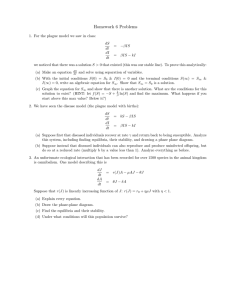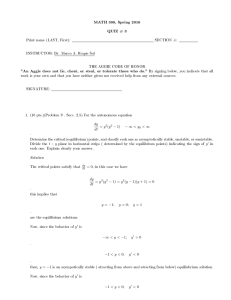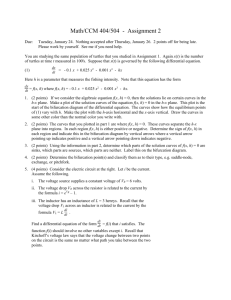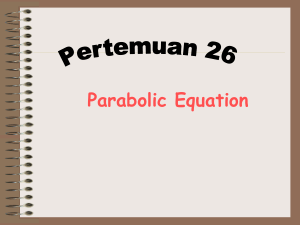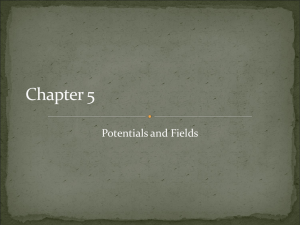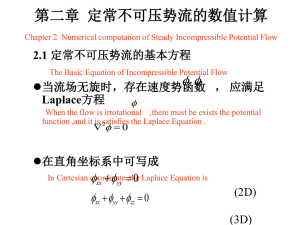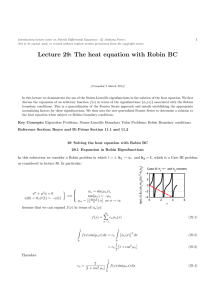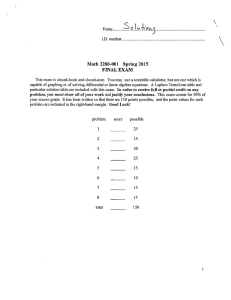Soluzioni Esame Meccanica Classica - PHY6426
advertisement
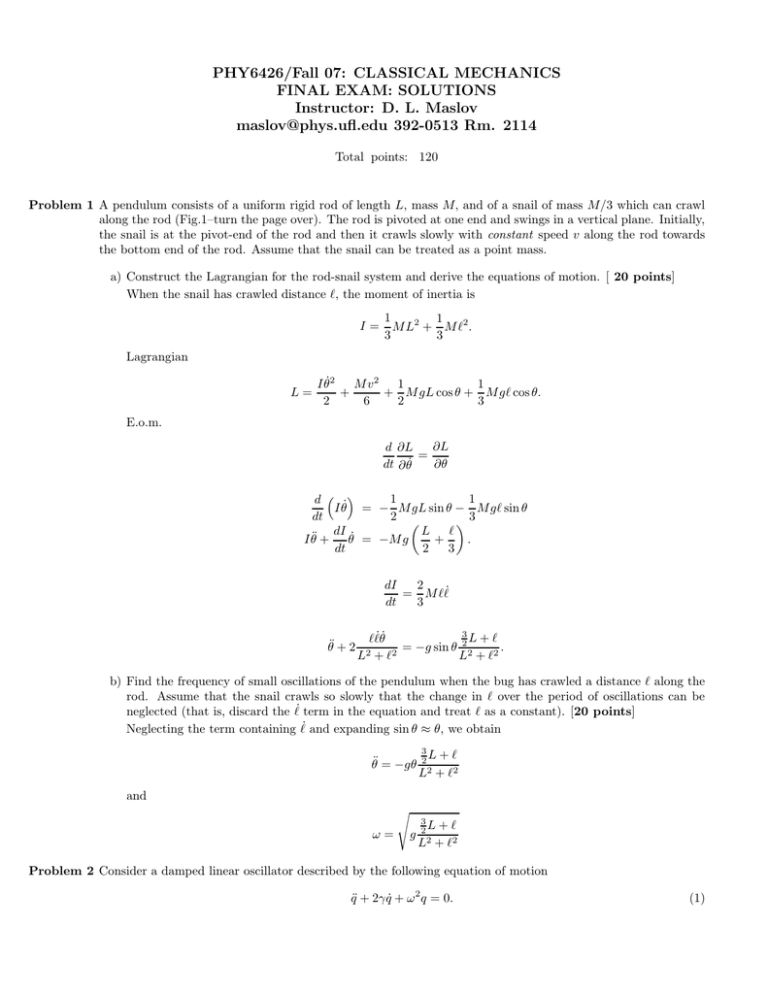
PHY6426/Fall 07: CLASSICAL MECHANICS FINAL EXAM: SOLUTIONS Instructor: D. L. Maslov maslov@phys.ufl.edu 392-0513 Rm. 2114 Total points: 120 Problem 1 A pendulum consists of a uniform rigid rod of length L, mass M, and of a snail of mass M/3 which can crawl along the rod (Fig.1–turn the page over). The rod is pivoted at one end and swings in a vertical plane. Initially, the snail is at the pivot-end of the rod and then it crawls slowly with constant speed v along the rod towards the bottom end of the rod. Assume that the snail can be treated as a point mass. a) Construct the Lagrangian for the rod-snail system and derive the equations of motion. [ 20 points] When the snail has crawled distance `, the moment of inertia is I= 1 1 M L2 + M `2 . 3 3 Lagrangian L= I θ̇2 M v2 1 1 + + M gL cos θ + M g` cos θ. 2 6 2 3 E.o.m. ∂L d ∂L = dt ∂ θ̇ ∂θ 1 1 d I θ̇ = − M gL sin θ − M g` sin θ dt 2 3 dI ` L . I θ̈ + θ̇ = −M g + dt 2 3 dI 2 = M ``˙ dt 3 θ̈ + 2 3 ``˙θ̇ 2L + ` = −g sin θ . L2 + ` 2 L2 + ` 2 b) Find the frequency of small oscillations of the pendulum when the bug has crawled a distance ` along the rod. Assume that the snail crawls so slowly that the change in ` over the period of oscillations can be neglected (that is, discard the `˙ term in the equation and treat ` as a constant). [20 points] Neglecting the term containing `˙ and expanding sin θ ≈ θ, we obtain θ̈ = −gθ 3 2L + ` L2 + ` 2 and ω= s g 3 2L + ` L2 + ` 2 Problem 2 Consider a damped linear oscillator described by the following equation of motion q̈ + 2γ q̇ + ω 2 q = 0. (1) 2 a) Assuming the Lagrangian of this system can be written as 1 2 1 2 2 mq̇ − mω q , L = f (t) 2 2 (2) find such a function f (t) that the Euler equation reproduces the equation of motion (1). To define f (t) uniquely, assume that f (0) = 1. [10 points] d ∂L ∂L = dt ∂ q̇ ∂q d (f (t) mq̇) = −f (t) mω 2 q dt f˙mq̇ + f mq̈ = − − f (t) mω 2 q f˙ q̈ + q̇ = −ω 2 q. f The e.o.m. is reproduced, if f˙ = 2γ. f Solving this equation with the initial condition f (0) = 1, we obtain f (t) = exp (2γt) . b) Construct the Hamiltonian H (q, p) using the Lagrangian from Eq. (2) with f (t) found in part a). [15 points] ∂L = f (t) mq̇ ∂ q̇ p . q̇ = mf (t) p = The Hamiltonian p2 1 + f (t) mω 2 q 2 2mf (t) 2 2 1 p + e2γt mω 2 q 2 . = e−2γt 2m 2 H = q̇p − L = c) For the generating function F2 (q, P, t) = exp (γt) qP, find the transformed Hamiltonian K (Q, P, t) and show that K is conserved. [15 points] ∂F2 = eγt P ∂q ∂F2 Q = = eγt q ∂P q = e−γt Q p = K=H+ ∂F2 = H + γqP eγt . ∂t H is new variables 2 H = e−2γt 2 P2 1 1 (eγt P ) + e2γt mω 2 e−γt Q = + mω 2 Q2 2m 2 2m 2 3 P2 1 + mω 2 Q2 + γ e−γt Q P eγt 2m 2 P2 1 = + mω 2 Q2 + γQP. 2m 2 K = K does not depend on time and is, therefore, conserved. Problem 3 A non-linear oscillator has a potential given by V (x) = 1 2 λ kx − mx3 , 2 3 where λ is a small parameter. Find the solution of the equation of motion to first order in λ, assuming that x (0) = 0 and ẋ (0) = v0 . [40 points] Hint: apply the initial conditions at each step of the perturbation theory. E.o.m. ẍ + ω02 x = λx2 , where ω02 = k/m. Perturbation theory x = x0 + x1 , where x0 = A cos ωt+B sin ωt. To zeroth order in λ, substitute x = x0 into the e.o.m. and neglect the non-linear term: −Aω 2 cos ωt + Aω02 cos ωt − Bω 2 sin ωt + Bω02 sin ωt = 0 → ω = ω0 . Taking into account the initial conditions, x0 = v0 sin ω0 t. ω0 To first order in λ, keep only the λx20 term in the RHS of the e.o.m. ẍ1 + ω02 x1 = λx20 = λ v0 ω0 2 sin2 ω0 t = 1 λ 2 v0 ω0 2 1 − λ 2 v0 ω0 2 cos 2ω0 t. A general solution of the inhomogeneous linear differential equation is a sum of a fundamental solution of the homogeneous equation and a particular solution of the inhomogeneous equation: x 1 = xf + xp . A fundamental solution xf = D cos ω0 t + E sin ω0 t. We can look for a particular solution of the following form xp = F + G cos 2ω0 t. Substuting back into the equation, we find 2 v0 ω0 2 1 v0 −4Gω02 cos 2ω0 t + Gω02 cos 2ω0 t = − λ cos 2ω0 t. 2 ω0 2 1 v0 −3Gω02 cos 2ω0 t = − λ cos 2ω0 t. 2 ω0 2 v0 λ G = 2 6ω0 ω0 F = λ 2ω02 4 snail l L FIG. 1: 2 2 v0 λ v0 + cos 2ω0 t ω0 6ω02 ω0 2 2 v0 λ v0 λ + =0 x1 (0) = 0 → D + 2ω02 ω0 6ω02 ω0 2 2λ v0 D = − 2 3ω0 ω0 x1 = D cos ω0 t + E sin ω0 t + λ 2ω02 The zeroth order solution already satisfies the initial condition ẋ0 (0) = v0 . Therefore, the first-order correction must satisfy ẋ1 (0) = 0, which gives E = 0. Finally, 2λ x1 (t) = − 2 3ω0 v0 ω0 2 λ cos ω0 t + 2ω02 v0 ω0 2 λ + 6ω02 v0 ω0 2 cos 2ω0 t

